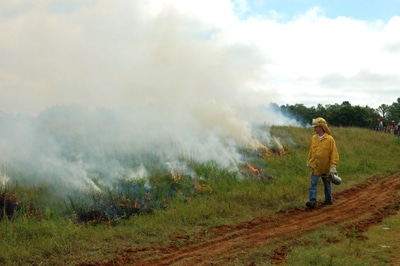USFWS and OCC successful Prescribed Burn Program expanding
An agreement between the U.S. Fish and Wildlife Service (USFWS) and the Conservation Commission (OCC) to help four conservation districts facilitate prescribed burning on private lands provided such positive results that the two agencies have agreed to extend the project. The purpose of the project is to use controlled burning as a tool to restore ecosystems and landscapes to their historical biological diversity and productivity.

“Prescribed burning is an incredibly valuable land management tool,” said Mike Thralls, OCC executive director. “In contrast to the danger posed to human lives, livestock and property by wildfire, prescribed burning associations allows well-trained teams of people to choose the time and conditions to conduct burns with safety as the foremost consideration,” he said. “Prescribed burns not only remove the fuel that would feed wildfires, they also remove invasive plant species. That helps maintain and restore the native plant ecology and promotes the native wildlife ecology,” Thralls said.
The original agreement for $50,000 for four conservation districts was approved by OCC in September 2008. USFWS provided $12,500 to OCC for each of the districts to help local prescribed burn associations with personnel, facilities, equipment, materials or administrative support to implement prescribed burns in their areas. Those districts were Dewey County, Ellis County, Upper Washita (Roger Mills County) and Woods County Conservation Districts. Recently USFWs and OCC signed a new agreement for $100,000 to expand the program.
The goal of the original agreement was to conduct prescribed burns on approximately 8,000 to 10,000 acres in western Oklahoma between August 2008 and August 2010. While the spring of 2009 did not offer optimum conditions for conducting burns, the four prescribed burn associations in those areas did accomplish 29 burns on 15,050 acres — exceeding the 10,000-acre goal of the two-year project.
Here are some details on activities in each of the four conservation districts:
Dewey County Conservation District – South Canadian Burn Association
The South Canadian Burn Association held two outreach meetings in December 2008 and January 2009 to educate the public and gain members, currently numbering 32. Using the grant funds the Upper Washita Conservation District and the burn association purchased a four-wheel all-terrain-vehicle with brush guard, 200-gallon skid sprayer and two 25-gallon sprayers, as well as various drip torches, swatters and radios. The burn association had a particularly challenging year as 60,000 acres (approximately eight percent) of Dewey County burned in a wildfire on March 6, 2009. Still, the South Canadian Burn Association conducted 10 prescribed burns in the spring of 2009 for a total of 7,634 acres. An additional 6,700 acres are planned for spring 2010.
Ellis County Conservation District – Northwest Range Fire Management Association
One outreach meeting was conducted in February 2009 for the Northwest Range Fire Management Association whose current membership is 50. Eight burns were conducted in the spring of 2009 by the association for a total of 2,010 acres. The association is making plans to purchase or build several slip-on skid sprayer units this winter.
Upper Washita Conservation District – Roger Mills Prescribed Burn Association
The Roger Mills Prescribed Burn Association held a general membership and recruitment dinner in February 2009 and currently has 59 members. With funds received through the Upper Washita Conservation District, along with a truck used as a trade-in, the burn association purchased two trucks — a 1992 diesel pickup truck and a 1-ton flat bed dually four-wheel drive truck. The Sweetwater Fire Department has allowed the association to use one of their older brush units to mount on the second truck. Seven burns were conducted for a total of 1,725 acres before burn bans in the spring of 2009 prohibited the association from burning more. Fifty-five people contributed 260 hours in carrying out the burns and to date expenses including fuel total $370. Future plans call for a meeting with equipment demonstrations, help on writing burn plans and a presentation by John Weir from the Natural Resource Ecology and Management Department at Oklahoma State University on OK-FIRE, a joint project among OSU, the Oklahoma Climatological Survey and the USDA Forest Service. The OK_FIRE website helps provide weather-based decision support tools for wildland fire management in Oklahoma.
Woods County Conservation District – Cimarron Range Preservation Association
The Cimarron Range Preservation Association, with a current membership of 30, held an outreach meeting in February 2009. Presentations were given on the benefits of prescribed fire, what to know before you burn and how to develop a burn plan. With the funds received through the Woods County Conservation District, the association purchased a used one-ton pickup from the county and a slide-in spray unit as well as a few backpack sprayers and drip torches. Dry and windy conditions predominated in the spring of 2009 for Woods County. Despite this fact, the association conducted four burns for a total of 3,681 acres.
